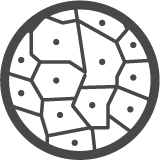CHITOSAN KEY PROPERTIES
Supports an anti-inflammatory environment
As a polysaccharide, chitosan is recognized naturally by the body. A low Degree of Acetylation (DA) has been shown to support M2 anti-inflammatory macrophage conditions.1,2
Inhibits fibroblast proliferation and infiltration
Fibroblasts have been shown to not proliferate on chitosan films. This behavior may be related to their high adhesion to the material which would inhibit their growth.3

Supports Schwann cell activity
Low DA chitosan films have been shown to favor Schwann cell invasion and proliferation with appropriate cytoskeletal morphology.4,6
Has antimicrobial properties
Preclinical studies have shown that chitosan exhibits antimicrobial activity.5,9,10

Is biodegradable
A natural biodegradable biopolymer, chitosan undergoes enzymatic degradation into recognizable, biocompatible components. The low DA composition contributes to mechanical stability, neutral pH, and degradation products that have been shown to be beneficial to tissue healing.6,7

Fully resorbs
Chitosan is primarily depolymerized by lysozyme, leading to full resorption. The degradation products of chitosan are bio-friendly (glucosamine, N-acetylglucosamine, and chitooligosaccharides),6 as well as supportive throughout the healing process.8
SCIENTIFIC EVIDENCE
Enhancing the Outcome of Traumatic Sensory Nerve Lesions of the Hand by Additional Use of a Chitosan Nerve Tube in Primary Nerve Repair: A Randomized Controlled Bicentric Trial
In Vitro Evaluation of Cell-Seeded Chitosan Films for Peripheral Nerve Tissue Engineering
Chitosan tubes of varying degrees of acetylation for bridging peripheral nerve defects
Chitosan Degradation Products Promote Nerve Regeneration by Stimulating Schwann Cell Proliferation via miR-27a/FOXO1 Axis
The Beneficial Effect of Chitooligosaccharides on Cell Behavior and Function of Primary Schwann Cells is Accompanied by Up-Regulation of Adhesion Proteins and Neurotrophins
Investigation of cell adhesion in chitosan membranes for peripheral nerve regeneration
Chitosan-film enhanced chitosan nerve guides for long-distance regeneration of peripheral nerves
Chitosan conduit combined with hyaluronic acid prevent sciatic nerve scar in a rat model of peripheral nerve crush injury
The regeneration of transected sciatic nerves of adult rats using chitosan nerve conduits seeded with bone marrow stromal cell-derived Schwann cells
Comparative Evaluation of Chitosan Nerve Guides with Regular or Increased Bendability for Acute and Delayed Peripheral Nerve Repair: A Comprehensive Comparison with Autologous Nerve Grafts and Muscle-in-Vein Grafts
Strategies to improve nerve regeneration after radical prostatectomy: a narrative review
REFERENCES
-
Vasconcelos DP, Fonseca AC, Costa M, et al. Macrophage polarization following chitosan implantation. Biomaterials. 2013;34(38):9952-9959. doi:10.1016/j.biomaterials.2013.09.012
-
Oliveira MI, Santos SG, Oliveira MJ, Torres AL, Barbosa MA. Chitosan drives anti-inflammatory macrophage polarisation and pro-inflammatory dendritic cell stimulation. Eur Cell Mater. 2012;24:136-153. Published 2012 Jul 24. doi:10.22203/ecm.v024a10
-
Chatelet C, Damour O, Domard A. Influence of the degree of acetylation on some biological properties of chitosan films. Biomaterials. 2001;22(3):261-268. doi:10.1016/s0142-9612(00)00183-6
-
Carvalho CR, López-Cebral R, Silva-Correia J, et al. Investigation of cell adhesion in chitosan membranes for peripheral nerve regeneration. Mater Sci Eng C Mater Biol Appl. 2017;71:1122-1134. doi:10.1016/j.msec.2016.11.100
-
Ke CL, Deng FS, Chuang CY, Lin CH. Antimicrobial Actions and Applications of Chitosan. Polymers (Basel). 2021;13(6):904. Published 2021 Mar 15. doi:10.3390/polym13060904
-
Matica A. Biodegradability of chitosan-based products. New Front Chem. 2017;26:75-86.
-
Suyeon Kim, “Competitive Biological Activities of Chitosan and Its Derivatives: Antimicrobial, Antioxidant, Anticancer, and Anti-Inflammatory Activities”, International Journal of Polymer Science, vol. 2018, Article ID 1708172, 13 pages, 2018.
-
Wang Y, Zhao Y, Sun C, et al. Chitosan Degradation Products Promote Nerve Regeneration by Stimulating Schwann Cell Proliferation via miR-27a/FOXO1 Axis. Mol Neurobiol. 2016;53(1):28-39. doi:10.1007/s12035-014-8968-2
-
Lillo L, Alarcón J, Cabello G, Céspedes C, Caro C. Antibacterial activity of chitooligosaccharides. Z Naturforsch C J Biosci. 2008;63(9-10):644-648. doi:10.1515/znc-2008-9-1005
-
Jeon YJ, Park PJ, and Kim SK (2001), Antimicrobial effect of chitooligosaccharides produced by bioreactor. Carbohydr. Polym. 44, 71-76.
Chitosan is the biomaterial used in the NeuroShield Chitosan Membrane, a product designed to be an interface between the nerve and the surrounding tissue for uses to treat nerve injuries. Instructions for use, precautions, and further information on the published research supporting the statements about chitosan may be found at checkpointsurgical.com.
4030-MKT-027-A

